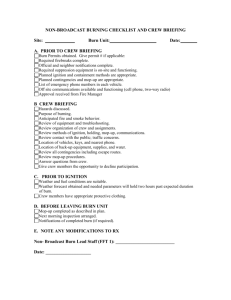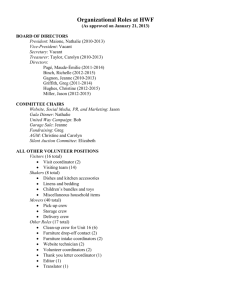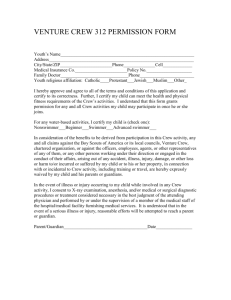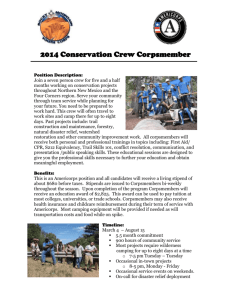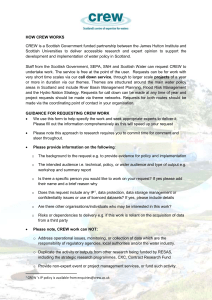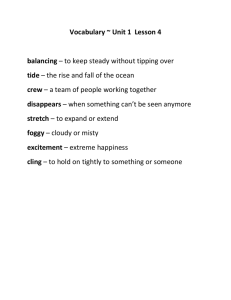Estimating Activity Durations
advertisement
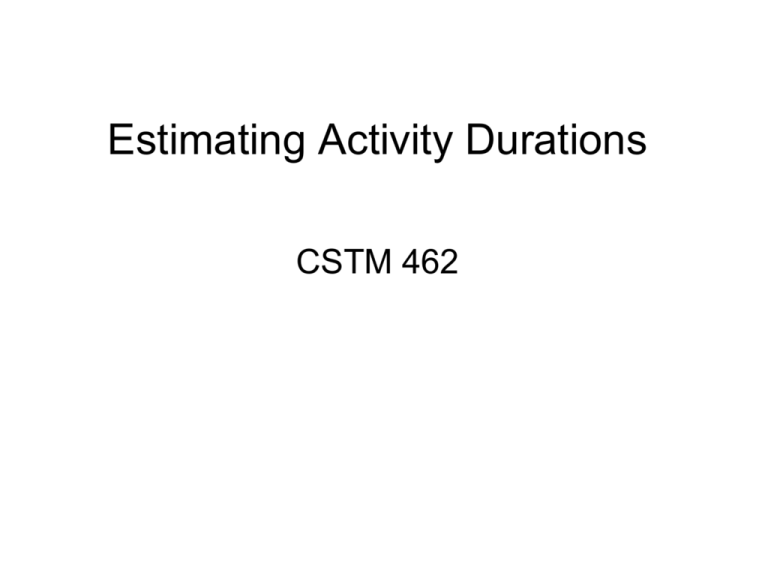
Estimating Activity Durations CSTM 462 Estimate activity durations • Activity durations should be estimated based on available resources which include labor, material and equipment. • These durations should reflect the planned resource productivity on anticipated site conditions. • Key to production monitoring and controlling day-to-day construction. Not Organized Organized Summarized Time Unit Selection Activity durations can be expressed in any convenient time unit, depending on the objective of the scheduling effort. These units include the following: • Years • Months • Weeks • Days (most common) • Hours (rarely used) Resource Availability The key to estimating activity durations is the availability of resources. These resources include the following: • Labor • Equipment • Material • Subcontractors Quantity and Productivity Data Sources • • • • • • • • Quantity Takeoff Bid Estimate Past Experience Outside Information Estimating Guides Industry and trade organizations Manufacturers, Fabricators and suppliers Specialty Contractors Calculating Activity Durations Two elements go into calculating durations... – Work Quantity – Production Rate Work Quantity Activity Duration = Production Rate therefore… 500 cy 50 cy / day = 10 days Necessary Information • Quantity of Work • Production Rate – Total Hours – Based on a Crew • • • • Productivity Crew Mix Work Schedule Project Calendar Estimating Durations Work Quantity x Production Rate = Total Hours from Material Take-Off (aka Quantity Survey) manhours per unit or MH/Qty Common units include… LS, EA, LF, CY, SF, BF and SY ( TOTAL HOURS x Productivity Factor (Actual to Estimate) Factors that Impact Productivity: - Weather - Proper Equipment - Supervision - Work Conditions - Learning Curve - Ability/Experience/Skill Level - Rework ) / Burn Rate = DURATION (usually days) Factors that Determine Burn Rate: -Crew Mix… Number of Workers -Work Schedule… 5-8’s, 6-9’s, etc. hours/day Burn rate = (crew mix) x (work schedule) 1 carpenter and 3 laborers working 5 - 8’s therefore, the burn rate is… 4 workers x 8 hrs./day = 32 hours/day Sample Problem - Givens… How long will it take to complete this activity? Activity: Quantity: Production Rate: Crew Mix: Work Schedule: CIP Concrete Grade Beam 3,000 sf .08 mh/sf 3 Carpenters & 2 Laborers 40 hour work week w/ 5 - 8’s Note: No productivity factor is provided…assume 1.0 Sample Problem - Solution Step #1: Work Quantity x Production Rate = Total Hours 3,000 sf x .08 mh/sf = 240 hours Step #2: ( TOTAL HOURS x Productivity Factor (Actual to Estimate) ) / Burn Rate = DURATION (usually days) ( 240 mh x 1.0 ) / 40 mh/day* = 6 days * Burn rate = (crew mix) x (work schedule) 5 x 8 = 40 man-hours/day Activity Duration Calculation Based on Material Quantity Quantity to Install Production Rate Production Rate Typical Crew Size Work Hours 9900 220 0.1455 4 8 Pounds Quantity/Day MH/Quanittiy Men Hours/Day Therefore: Total Manhours Burn manhours per day Activity Duration Assign Resources: 1440 MH (Quantity x Production Rate) 32 45.00 Work Days (Total MH/Hours per Day*Crew Size) Factors Affecting Activity Durations You plan it and guess what happens? Poor productivity in relation to: • • • • • • • • Nature of the work Labor and Equipment Productivity Management skill Material and Equipment Availability Seasonal Conditions Work Restrictions Quality of Work Concurrent Activities Labor Productivity How the actual job compares to the budget or estimate. • Work hours • % Complete • Unit rate This information can then be converted to a productivity factor which will increase or decrease the overall activity duration. Considerations • Productivity should increase as experience is gained for repetitive tasks. • Activities composed of repetitive tasks should benefit from the increased task productivity and have decreasing activity durations. • Depending on the work, difficulty can increase if uncommon work tasks are grouped together in an activity. Considerations • Productivity can vary significantly from project to project, location to location and crew to crew. • Labor productivity is a function of a number of factors that include training, experience, motivation and labor restrictions among others. Productivity Factor Example Budget/Estimate contains 240 man-hours Actual expended to date is 100 man-hours Activity is fifty percent complete • Option #1: – 100/120= .8333 • Option #2 – 120/100= 1.2 Good or Bad? Look at Productivity • Actual/Budget • Budget/Actual Less than 1 is good! More than 1 is good! Each company may look at different… In this class a productivity rate of less than one is good. Calculation…Adding Productivity Activity: CIP Concrete including form, reinforce, pour and finish Quantity: 5,000 cubic yards Crew Mix: 2 crews consisting of… 3 Carp & 2 Lab = 5 person crew Production rate: 6 man-hours per cubic yard (from the estimate) Work Schedule: 40 hrs/week…w/ 5 - 8 hour days Productivity Factor: .85 - based on beating the estimate Sample Problem - Solution Step #1: Work Quantity x Production Rate = Total Hours 5,000 cy x 6.0 mh/cy = 30,000 hours Step #2: ( TOTAL HOURS x Productivity Factor (Actual to Estimate) ) / Burn Rate = DURATION (usually days) ( 30,000 mh x .85* ) / 80 mh/day** = 318.75 days …round up & say 319 days * 30,000 hours x .85 = 25,500 hours ** Burn rate = (crew mix) x (work schedule) (5 x 8)*(2 crews) = 80 man-hours/day Crew Mix & Cost Turn man-hours into Costs Two crews consisting of… 3 carpenters & 2 laborers per crew 3 Carpenters @ 20.50/hour = $61.50 2 Laborers @ 16.25/hour = $32.50 • $32.50 + $61.50= $94/5 = $18.80 Crew Average Wage Rate • $18.80 x 2 crews = $37.60 Composite Average Wage • $37.60 x 30,000 hours = $1,128,000.00 vs. • $37.60 x 25,500 hours = $958,800.00 Resulting in a difference of $169,200 Variables to Evaluate for Duration • • • • • • • Production Rate Quantity or work in place Total man-hours Project Calendar Work Schedule Crew Size or Mix Productivity
